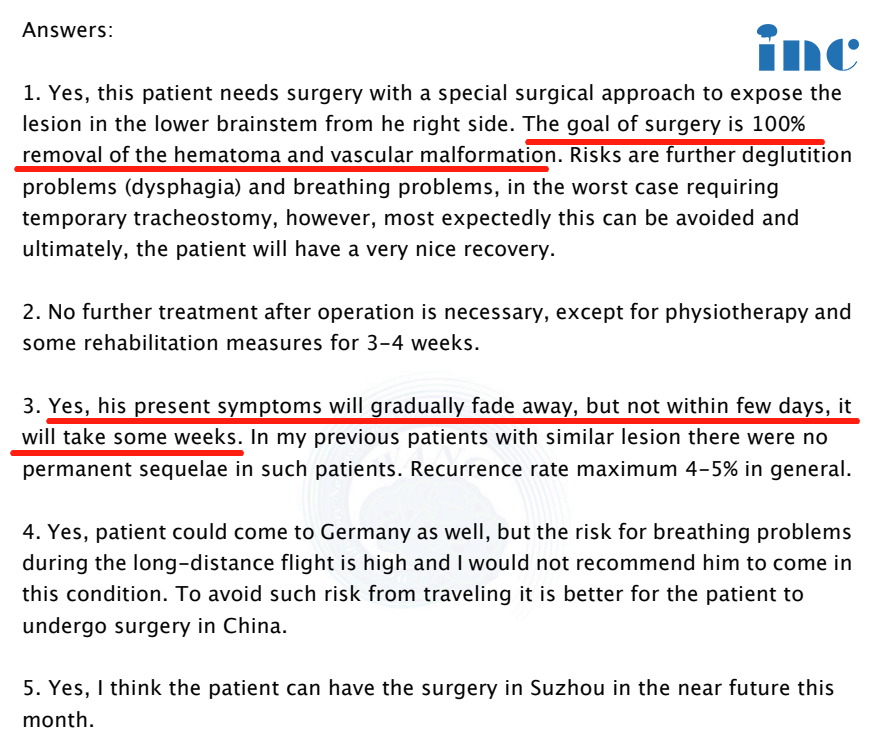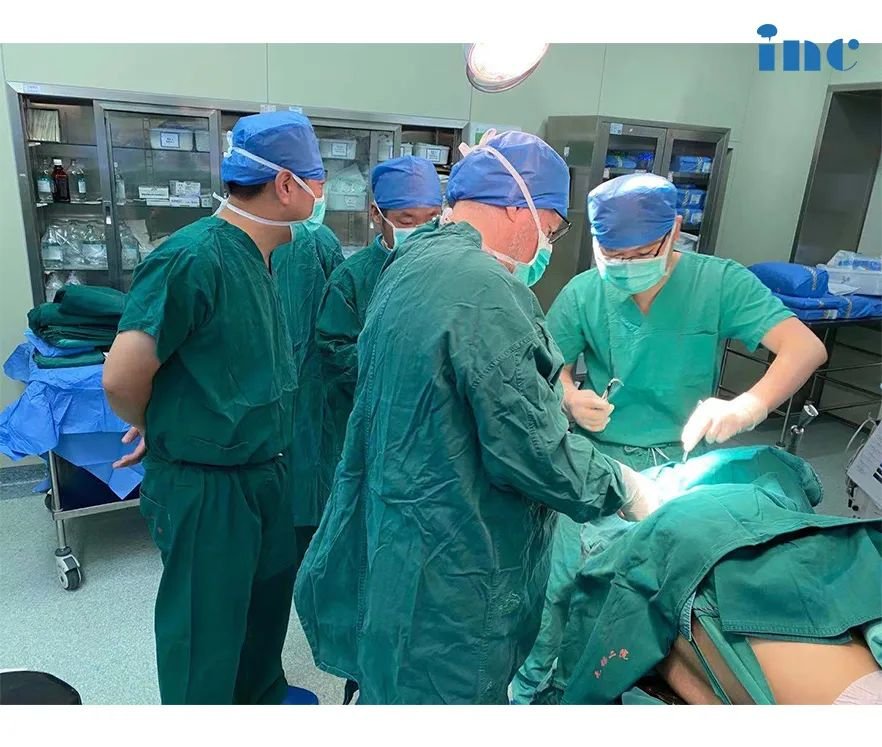Declared "as good as dead" after two hemorrhages,48 year old male, three years after surgery
Three years ago, Walter was in a coma. The cavernoma in his brainstem had hemorrhaged two times. At the time, he was declared “as good as dead” by his local doctors, giving him at best 20 more days. Because the lesion was deep inside his brainstem, surgery was most difficult. The treating physician deemed the cavernoma simply inoperable and advised the family to give up on treatment. . .
Just around that time, in June 2019, Professor Bertalanffy of the International Neurosurgeon's Circle was scheduled to come to China to perform surgical demonstrations with the team of the The First Affiliated Hospital of Soochow University. Together, they performed a surgery, that most deemed impossible, using a special approach to resect a deeply-seated cavernoma from the brainstem. Walter's life was hanging by a thread, and this surgery was his last chance.
Today, three years after the surgery, Walter is able to live and exercise just like any other healthy person. He jogs everyday. He says, since he already died once, he sees the preciousness of life in every minute, not wanting to waste any.
Walters journey
In 2021, when Professor Bertalanffy returned for another round of surgical demonstrations, Walter visited us in our Shanghai office for a follow-up interview. He said: "I had been to every major hospital in China, and everyone told me to treat conservatively. I was extremely discouraged. But when I found Professor Bertalanffy, I finally saw hope. . . I am very satisfied with the result of the surgery. I now live a life just like a normal person. And I also referred other patients to Professor Bertalanffy for surgery. I generally recommend patients with a brainstem cavernoma to seek treatment as early as possible. The longer you wait, the more critical your condition becomes. ”

After two hemorrhages, Walter had been declared "as good as dead"
Three years ago, at the age of 48, Walter developed a sudden headache. He couldn't walk anymore, his hands and feet went numb for more than twelve hours and he developed double vision. He was diagnosed with a hemorrhagic brainstem cavernoma in his lower pons and medulla oblongata. But this was not his first hemorrhage. After the previous bleeding, doctors had told him that he had a cavernoma in the pons of the brainstem, that surgery would be extremely difficult and very risky. He was treated conservatively and discharged 20 days later when his condition had somewhat stabilized.
But who could know that just one month later, Walter would develop even more serious symptoms: dizziness, weakness, blurred vision, being unable to walk just a few steps. Doctors told him that this time the hemorrhage was larger and that Walter was in a critical condition. If surgery was not done to remove the lesion, he would not last for more than one month. But faced with such a deep lesion in such a complex location, no one dared to perform the surgery for him.
Why are surgeries in the pons and medulla oblongata so difficult?
The greatest danger of a brainstem cavernoma is posed by its repeated bleedings. These bleedings are often quite small and happen very slowly. If a hemorrhage occurs in the brainstem, the spinal cord or the thalamus, it can cause very serious consequences, in the worst case it can be life-threatening. Therefore, aggressive treatment is generally preferred for cavernoma in these areas.
Walter's cavernoma was located in the area of the lower part of the pons and the medulla oblongata. These are all structures within the brainstem, the control center that regulates our most vital functions like breathing, heart rate, balance, and more. Additionally, the brainstem is very small and densely populated with nerve nuclei. The slightest injury during operation can cause loss of various neurological functions. Consequences are often irreversible and difficult for patients as well as their families to deal with.
Because of this high risk, the area of the brainstem has been considered a "no-go area" for surgeons, and until today, there are only a handful of surgeons truly qualified to operate on the brainstem.
A fortunate encounter
Unwilling to accept his death sentence, Walter and is family read through everything they could, asked around everywhere to find someone who could perform this brainstem surgery. At last, they learned about a professor in the International Neurosurgeon's Circle who was an expert in this area with over one thousand of successful surgeries on the brainstem-Professor Bertalanffy. Brainstem cavernoma resections alone, he had performed over 400 times with great results. In June 2019, Professor Bertalanffy would come to China again to perform another round of surgical demonstrations. Walter's family decided to grasp this chance and consult with Professor Bertalanffy.
Discussing Walter's case, INC's Professor Bertalanffy and his Chinese colleagues had different opinions on the feasibility of the surgery. Some thought there was little hope for Walter, while Professor Bertalanffy was convinced that the cavernoma could be resected utilizing a special surgical approach to expose the lesion in the lower part of the brain stem from the right side. The goal of the surgery would be 全切 resection. Risks would include further swallowing and breathing problems, and in the worst case scenario, a tracheostomy (an opening surgically created through the neck into the trachea-windpipe-to allow air to fill the lungs) would be required. However, all of these risk could be anticipated and therefore avoided. Furthermore, with physical therapy and rehabilitation, the patient had a good chance for a nice recovery.

At such a critical moment in his life, Professor Bertalanffy's evaluation gave Walter and his family one last hope of survival. As long as there was one more chance, they would not give up.
A life-saving surgery
After having agreed to receive surgery by Professor Bertalanffy, everything proceeded very rapidly. INC arranged admission to the hospital and scheduled the surgery, while Walter's family was anxiously waiting for the day of this life-saving surgery.
By the end of June 2019, Professor Bertalanffy performed the surgery with the assistance of the Soochow University First Affiliated Hospital's neurosurgical team. The surgery proceeded without complications, and Walker could leave the ICU on just the second day after his surgery. His pre-operative symptoms were already improving, and there were no new neurological deficits. On the 12th day after his surgery, Walter was discharged from the hospital and transferred to a rehabilitation facility to start rehabilitation. After a slow, three month long process of recovery, Walter's headaches and unsteady walking had gone. Three years after his surgery, Walter has resumed his normal work life.
His brainstem cavernoma had not recurred. During our last follow-up with Walter, we were glad to see that his condition was getting better every year. Before the surgery, Walter had a leg muscle strength of just 2, now he was as good as normal. He maintained regular exercises, jogging five to six kilometers every day. Although he still had a mild double vision and occasionally a poor balance, Walter said this did not have much of an impact on his normal life. He said, considering his situation before the surgery, when he was unable to swallow and could not move his whole lower body, he was very satisfied with his condition.
“Three years ago, I was sentenced to death and declared incurable. I still remember my weakness and fear. Thank you Professor Ba for saving my life! ” Walter's courage as well as that of his family led them to not give up in the face of death. This courage was also decisive for Walter's recovery and his regaining the strength that now allows him to life a normal life, cherishing every moment.

Walter's story is a lesson and an inspiration for everyone to not give up even in the most dire of circumstances.